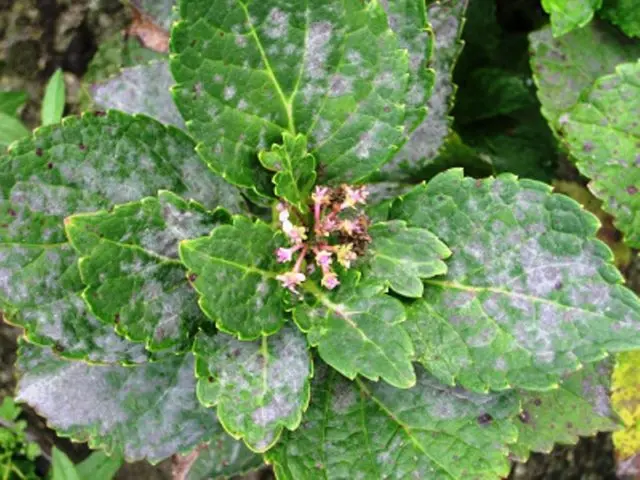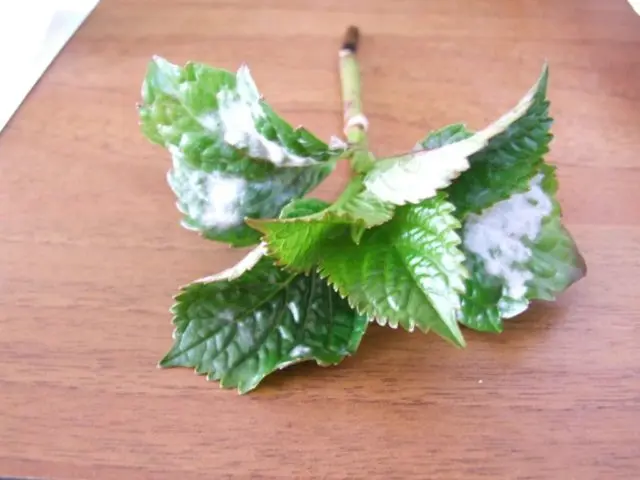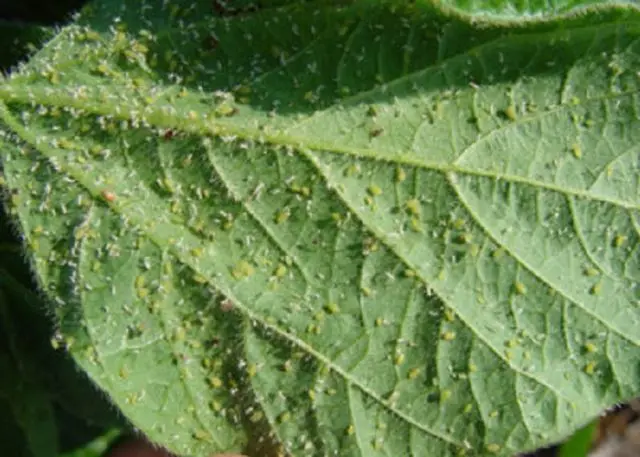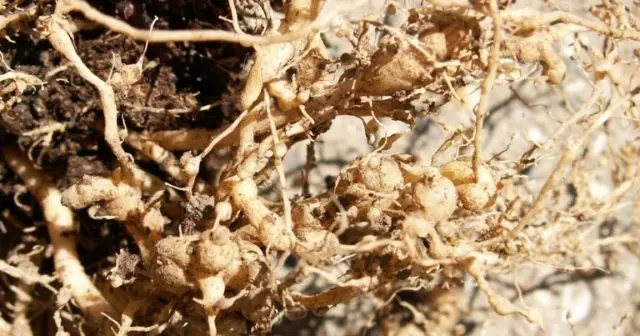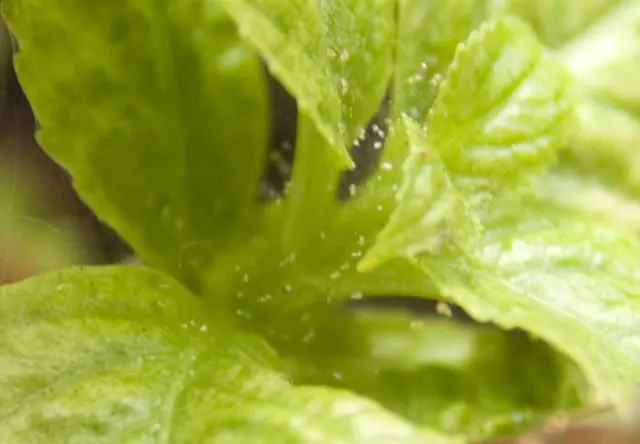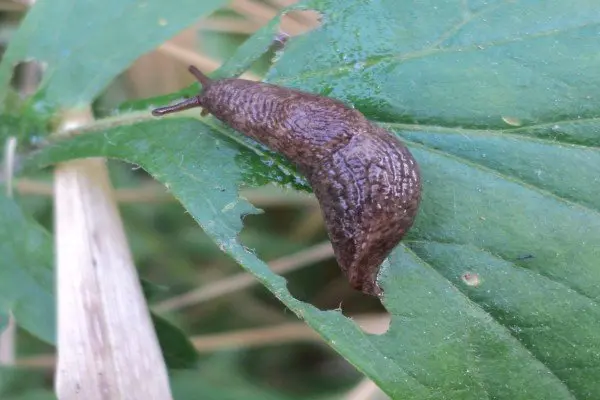Contents
White hydrangea is the most popular shrub from the family of the same name in garden plots. To decorate your front garden with beautiful flowering, you need to know how to properly plant and grow it.
Description of white hydrangea
In the garden, white hydrangea is usually represented by tree-like or paniculate varieties. In both cases, the plant rises an average of 2-2,5 m above the ground, has numerous thin shoots and heart-shaped green leaves. The leaves of the plant are usually large, up to 15-20 cm in length.
White hydrangea blooms from early summer to autumn with large inflorescences – spherical or paniculate, depending on the variety. Inflorescences consist of small white flowers, tied on young annual shoots.
A feature of a garden plant is that the shade of flowering directly depends on the acidity of the soil. Gives snow-white buds on neutral ground.
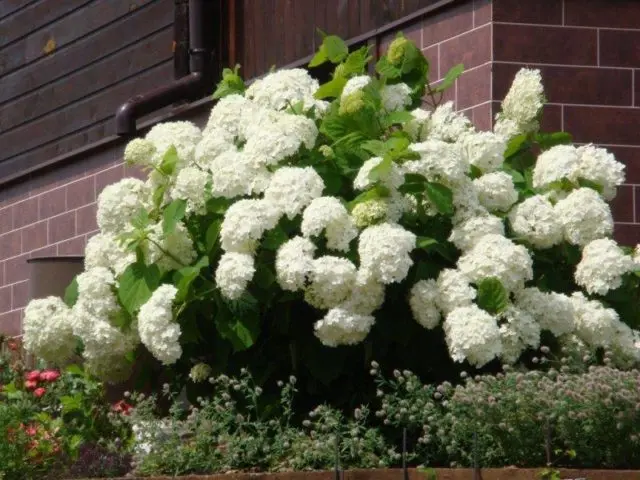
The shrub blooms with huge spherical inflorescences
The plant is quite unpretentious, it can bloom for about 10 years in a row in the same place in the garden, and sometimes more.
Varieties of white hydrangea
Varieties of garden white hydrangea are in the dozens. However, several of them are the most popular among summer residents.
Annabelle
Annabelle, or smooth hydrangea, is a plant up to 1,5 m in height and up to 3 m in diameter of the bush. The variety is characterized by oval large leaves with jagged edges, dark green foliage and very beautiful snow-white blooms. Annabelle’s white flowers form into large spherical inflorescences up to 25 cm wide.
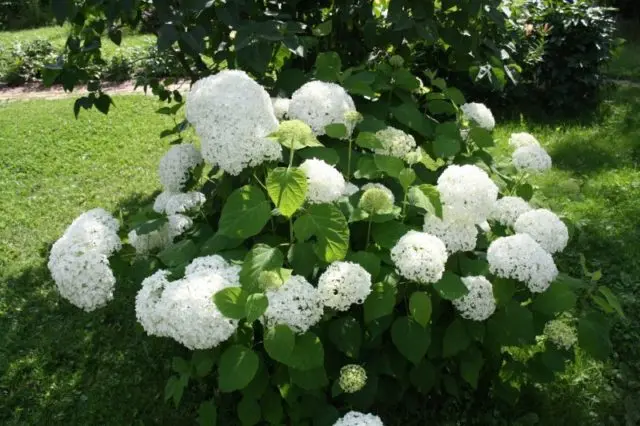
Annabelle is the most popular variety among gardeners.
Annabelle is an unpretentious variety that feels good on any soil. The main requirements are regular watering and the absence of direct sunlight.
Sterilis
White spray hydrangea Sterilis is also an upright shrub up to 1,5 m in height. The leaves of the plant are oval and slightly elongated, bright green with a bluish tinge on the underside. The flowers of this variety are light green at the very beginning of flowering, and then become snow-white and remain so until the end of the season.
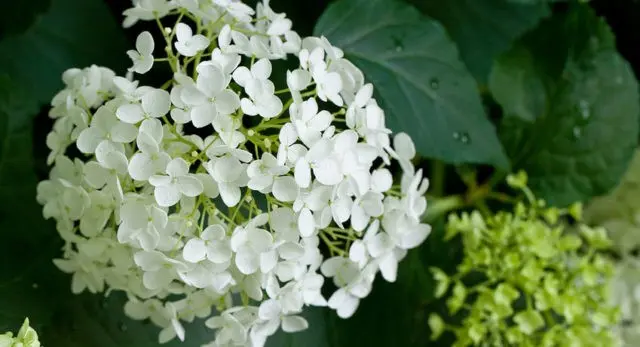
The Sterilis variety is distinguished by especially abundant flowering at the end of summer.
Especially magnificent white hydrangea Sterilis blooms in August. The shrub is undemanding to soils, but requires a large amount of moisture.
Grandiflora
Tree-like white hydrangea of this variety reaches 2 m in height and has green oval leaves up to 10 cm each. It blooms from July to September, the buds are light green and then white, collected in large corymbose inflorescences. At the very end of flowering, Grandiflora may acquire a light creamy hue.

Treelike Grandiflora – a large variety up to 2 m tall
Feels good on wet soils and loves lighted places with light shading. Grandiflora grows rapidly – the annual increase in growth can be up to 30 cm.
Kyushu
Paniculate white hydrangea grows up to 2,5 m and spreads a crown of 3 m in diameter. The stems of the shrub are reddish-brown, the ovate leaves are rich green and slightly pubescent. The plant bears white small flowers of 2-3 cm each, forming large paniculate inflorescences up to 25 cm in length. By the end of flowering, the white Kyushu panicles may acquire a light pinkish tint.

Kyushu is a beautiful and hardy panicled variety.
Gardeners love the Kyushu variety not only for its decorative effect. The shrub grows quickly and also has good frost resistance.
White Ball
The tree-like variety White Ball can grow up to 80 cm in height and brings large spherical inflorescences up to 30 cm in diameter, which is the reason for the name of the white hydrangea. Flowering begins in July, ends in September, snow-white inflorescences look spectacular in garden design. Sufficiently compact bushes are often used as hedges, since White Ball feels good in the lit areas of the garden.
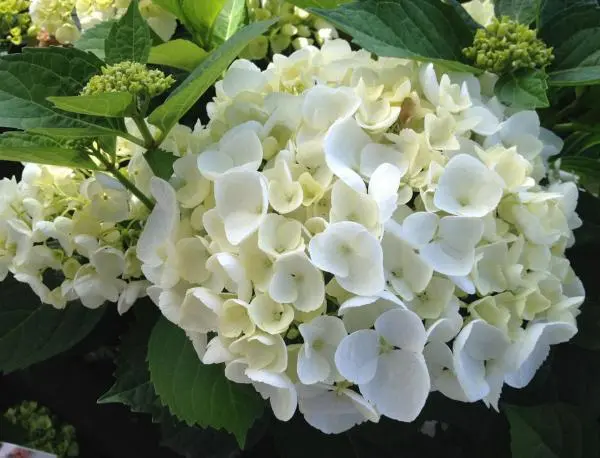
White Ball – a compact variety with large spherical inflorescences
White hydrangea in landscape design
To decorate the garden, white hydrangea is used very often; it looks extremely impressive against the background of summer greenery. The shrub is used for:
- creating hedges and delimiting the garden into separate zones;
- formation of group and single decorative compositions;
- decorating empty areas of the garden, for example, the space near the wall of the house;
- decoration of fences and hedges.
White hydrangea goes well with tall trees, other shrubs and perennials. The shrub can act as the basis of the composition when creating mixborders.
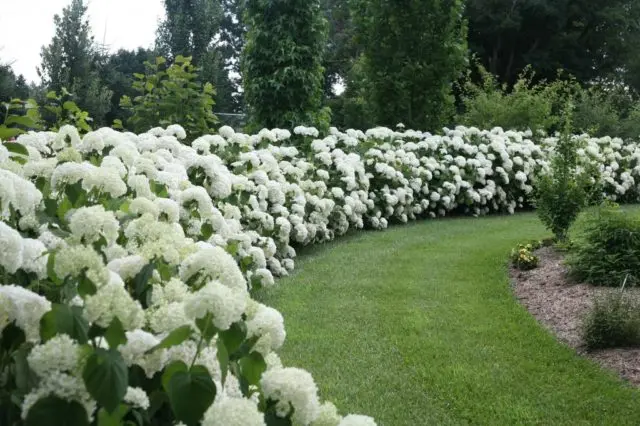
Flowering hedge looks especially impressive
White hydrangea is especially appreciated for the fact that it retains its decorative effect, including in early autumn. Most shrubs and perennials are already finishing flowering by this time, but the hydrangea is still pleasing to the eye with snow-white inflorescences.
Winter hardiness of white hydrangea
Different varieties have different cold tolerance. In general, white hydrangea calmly tolerates negative temperatures down to -25 ° C, some varieties can withstand drops to – 30 ° C. But for the winter period, the bush is recommended to be carefully covered to protect it from freezing.
Planting and caring for white hydrangea
Growing a lush shrub in your garden is not difficult, caring for it comes down to a few simple procedures. The plant does not make high demands on the gardener and needs only basic care.
Selection and preparation of the landing site
The white hydrangea prefers well-lit areas with light afternoon shade and protection from strong winds. The best place to plant a shrub is a site next to any building or tall trees.
Soils for white common hydrangea are best suited neutral or slightly acidic, fertile and loosened. Shrubs should not be planted on strongly acidic or calcareous soils, in both cases the culture will develop worse and, moreover, may change the color of the flowers.
Shortly before planting a shrub, the soil in the selected area must be dug up and humus, peat and sand added to it. With a strong acidification of the soil, you can add a little dolomite flour to it to bring the pH closer to neutrality, but you need to follow the measure.
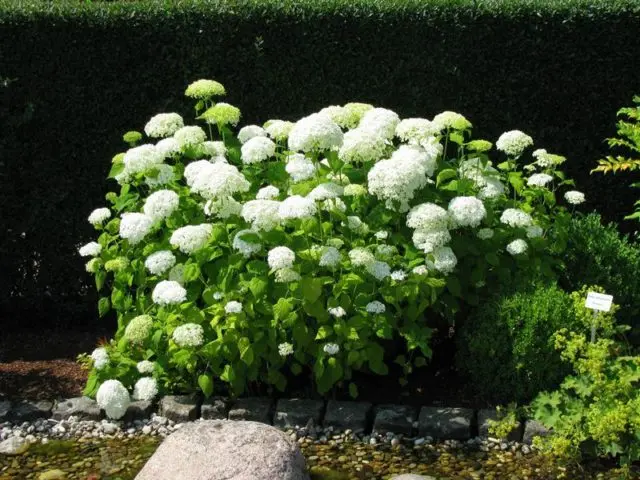
It is recommended to plant a shrub on neutral soil.
How to plant a white hydrangea
It is recommended to plant shrubs in the ground in May, after the return frosts have passed and the ground has warmed up. During the summer, the white hydrangea will have time to take root well and calmly endure the winter. In autumn, the plant is planted only in the southern regions, where winter temperatures remain warm enough.
Algorithm:
- A landing hole for a white hydrangea is dug in advance, about a month before planting. The hole should be about 50 cm wide and deep.
- The pit is half filled with specially prepared soil, usually coniferous soil is mixed with humus and peat and a little sand is added for greater looseness.
- Complex fertilizers are introduced into the hole – nitrogen, potassium and superphosphate, which will help the white hydrangea take root faster.
- Immediately before planting, the seedling is soaked in water for a couple of hours and its annual shoots are shortened by several buds.
After that, the seedling is set in the center of the dug hole, the roots are straightened inside it and sprinkled with the remains of the earth mixture, leaving the root collar above the ground. The soil is lightly rammed, then it is abundantly watered with 2 buckets of water and the trunk circle is mulched with tree bark or sawdust.
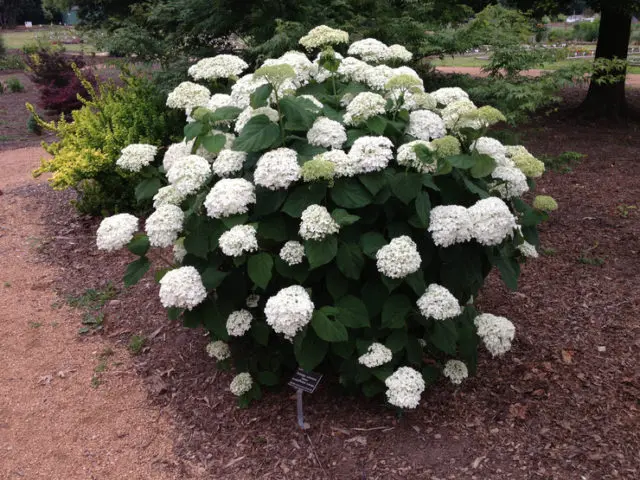
The plant loves nutritious soil with the addition of humus and peat
Watering and top dressing
White hydrangea loves moisture, so it needs additional watering. In dry weather, it is necessary to pour 20 liters of water under a bush every week, and the moisture should be clean and slightly warm, the plant does not like cold water. If the summer turned out to be rainy, then the shrub is moistened 1-2 times a month, but at the same time they make sure that the soil at the roots does not dry out.
It is recommended to feed the shrub three times a year:
- in early spring – nitrogenous fertilizers and organic matter;
- before flowering – superphosphate;
- at the end of summer – potassium sulfate or chicken manure.
It is recommended to carry out top dressing from the age of 3, since at first the white hydrangea has enough fertilizer applied during planting.
White hydrangea in the garden is not recommended to be fertilized with wood ash. But you can add a little potassium permanganate to the water, such a solution will protect the culture from fungal diseases and increase the frost resistance of the shrub.
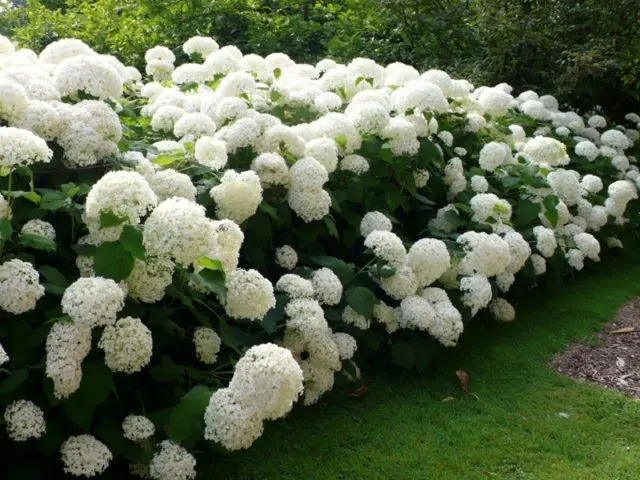
You need to water the shrub often – every week
Trimming
Since the white hydrangea grows quickly, it must be pruned every spring. The procedure is carried out in early spring, before the start of the growing season – diseased and old shoots are removed, and young branches are shortened by 5 buds.
In the first 2 years in the spring, when pruning, it is advised to remove small buds from the shrub. This will allow the plant to direct all resources to building roots and green mass, so later it will be able to bloom more abundantly.
How to prepare white hydrangea for winter
Winter hardiness in white hydrangea is average, although some varieties successfully tolerate extreme cold and can grow even in Siberia. But in any case, it is customary to cover the plant for the winter, and do it as follows:
- with the onset of autumn, the faded inflorescences are removed, and the branches of the shrub are bent to the ground and tied;
- the shrub is covered with agromaterial, burlap or spruce branches;
- the trunk circle is mulched with peat or compost.
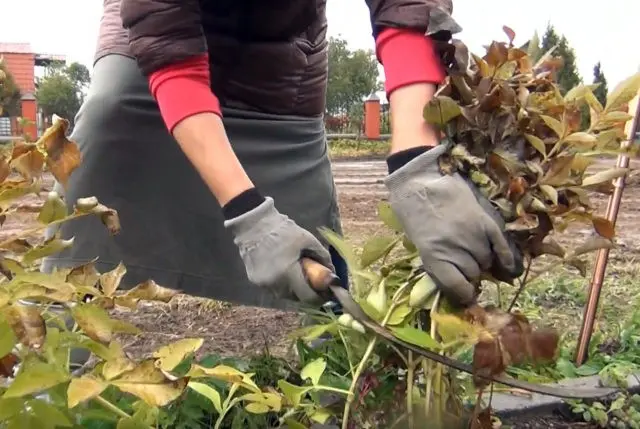
Before winter, wilted inflorescences are removed from the plant.
Small bushes can be surrounded by a special frame of the same height as the plant itself, and completely covered with fallen leaves inside it. The procedure is especially recommended for young bushes vulnerable to winter frosts.
It is not recommended to cover hydrangea bushes with a film – moisture accumulates under it, which leads to the development of fungal diseases. They remove the winter shelter from the white hydrangea in March or April, after the warm weather is finally established.
How to propagate white hydrangea
There are several ways to propagate hydrangea on the site:
- Layers. This method is very simple – it is enough to bend to the ground and fix a strong lower shoot in the soil at the beginning of summer, so that by autumn it will take root well. In the next season, layering can be transplanted to a separate place.
- By dividing the bush. The method is suitable for adult plants with a developed root system, in the spring a white hydrangea is dug up and divided into 2-3 parts, and then seated according to the standard algorithm in different areas.
- Cuttings. In early spring, you need to cut several young shoots from a hydrangea bush, soak them for 2 days in water, and then root them in a sand-peat mixture at home. Seedlings are transplanted into the ground in the second year, when they get a little stronger.

The easiest way to propagate the plant is by layering and dividing the bush.
If desired, white hydrangea can be propagated using seeds purchased at the store. Planting material is planted in nutrient soil in pots at the end of winter and seedlings are grown at home until the beginning of summer, and then planted outside. But seed propagation is used infrequently, it takes a lot of time, and it may not be crowned with success.
Diseases and pests
The immunity of the white hydrangea is average, but with improper care, the plant can suffer from fungal diseases and garden pests. Most often, shrubs are affected by:
- chlorosis, the disease develops on calcareous soils and with a lack of iron in the soil, hydrangea leaves begin to turn yellow and fall off ahead of time;

With chlorosis, the leaves become stained and begin to rapidly turn yellow.
- mučnistaâ rosa – with excessive moisture, the plant may suffer from a fungus, in which the leaves become covered with a whitish coating and begin to wither;

Powdery mildew is characterized by a whitish fluffy coating
- gray rot – in conditions of waterlogging, the leaves become covered with a gray coating, and then dry.

Gray rot leaves a light bloom on the leaves, similar to mold
To combat fungi, it is necessary, first of all, to remove all the affected areas of the shrub, and then treat the plant with copper sulphate or chemicals, for example, Fundazol.
Of the pests, the danger to the plant is mainly:
- green aphid, small pests can greatly eat a decorative bush;

Aphids merge with the green foliage of the white hydrangea, but upon closer inspection, it is not difficult to notice them.
- nematodes – worms infect all parts of the hydrangea and prevent it from developing;

It is very difficult to fight nematodes, usually sick hydrangeas are simply destroyed
- spider mite – the insect feeds on the leaves and juices of the stem, because of which the plant begins to fade;

The spider mite prevents the development of the bush and feeds on the green mass of the plant
- slugs – Garden pests eat leaves and can cause serious damage to ornamental shrubs.

Slugs must be fought so as not to lose the entire hydrangea bush
If, during the next inspection, pests or their larvae can be found on the leaves, the shrub is treated with soapy water, garlic infusion or insecticidal preparations.
Conclusion
White hydrangea is a very beautiful shrub that is popular with gardeners. On fertile soil and with good moisture, the hydrangea develops quickly and pleases the eye with snow-white blooms until the beginning of autumn.











